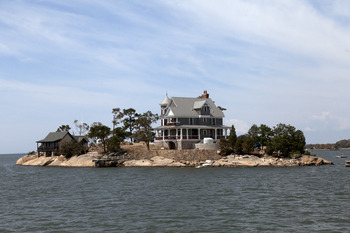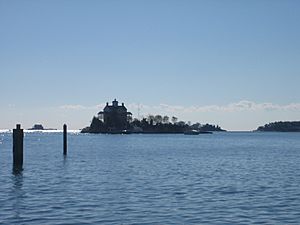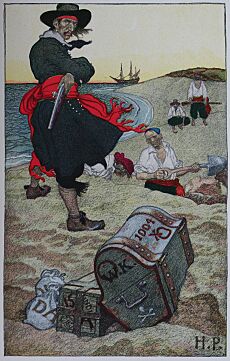Thimble Islands facts for kids
 |
|
| Geography | |
|---|---|
| Location | Branford, Connecticut |
| Coordinates | 41°15′52″N 72°45′11″W / 41.26444°N 72.75306°W |
| Total islands | 100+ |
| Administration | |
|
United States
|
|
| State | Connecticut |
The Thimble Islands are a group of small islands found in Long Island Sound. They are located near the town of Branford, Connecticut, specifically around the harbor of Stony Creek. These islands are part of the United States. Local police and the US Coast Guard help keep them safe.
These islands are made of strong pink granite rock. This rock was once the tops of hills before the last ice age. This makes the Thimble Islands very stable. Many other islands in Long Island Sound are made of loose rocks left behind by melting glaciers.
Contents
Exploring the Thimble Islands' Past
The native Mattabeseck people called these islands Kuttomquosh, which means "the beautiful sea rocks." There are many granite rocks, ledges, and outcroppings. The exact number of islands changes depending on how small a rock needs to be to count as an island. They can be anywhere from 100 to 365! These islands are also a resting spot for migrating seals.
Who Discovered the Thimbles?
The first European to find the islands was Adrian Block in 1614. There's a fun legend that says the famous pirate Captain Kidd buried his treasure here. This legend has made many treasure hunters curious over the years. However, most people think his treasure might be on Gardiners Island, which is about 30 miles (48 km) away.
What Are the Thimbles Named After?
People say the islands are named after the thimbleberry plant. This plant is related to the black raspberry. However, thimbleberries are not very common in this area. Other types of blackberry and raspberry plants are sometimes called thimbleberries by people who live nearby.
Life on the Islands: A Look Back
In the 1800s, there was a big oyster farming business around these islands. A writer named Diana Muir spent her childhood summers on Lewis Island. Her family's large house was built with money from the oyster trade.
By 2007, a private buyer named Christine Svenningsen bought ten of the islands. This included Rogers Island. Over the years, some islands have been put up for sale, like Wheelers Island and Belden Island.
The Thimble Islands: A Historic Place
The Thimble Islands are part of a special area called the Stony Creek–Thimble Islands Historic District. This district was added to the National Register of Historic Places in 1988. The historic area covers about 1,400 acres (570 ha). It includes the islands, the road leading to them, and nearby properties in Stony Creek. This area has many old buildings and structures.
Meet the Thimble Islands
Here are some of the largest Thimble Islands:
- Horse Island: This is the biggest island at 17 acres (6.9 ha). Yale University owns it and uses it as a place to study nature.
- Money Island: This island is 12 acres (4.9 ha) and has a small village with 32 houses and a library.
- Governor Island: This island is 10 acres (4.07 ha) and has 14 houses.
- Rogers Island: This island is 7.75 acres (3.14 ha). It is also known as Yon Comis Island.
- Bear Island: This island has a quarry where high-quality granite was dug up. This granite was used for famous buildings like the Lincoln Memorial and the base of the Statue of Liberty. A much larger quarry nearby, Stony Creek Quarry, provided granite for the Brooklyn Bridge.
- Davis Island: President William Taft used this island as his "Summer White House" for two years.
- Outer Island: Southern Connecticut State University uses this island for nature studies. It is also part of the Stewart B. McKinney National Wildlife Refuge. Visitors can go to Outer Island, and volunteers are there during the summer.
Other named Thimble Islands include Hen Island, East Stooping Bush Island, Potato Island, Smith Island, and Kidd's Island.
Kidd Island: A Pirate's Legend?
Kidd's Island is named after the famous Captain Kidd. It's one of many places in the Thimble Islands that carry his name. There's also Kidd's Harbor and Kidds Lane. Money Island was even named because of his treasure! Local stories say that Captain Kidd loved to explore the Thimbles. He might have even buried some of his riches here.
Nature on the Thimble Islands
The nature on these islands has been changed a lot by people over thousands of years. For example, during the American Revolutionary War, all the trees on every island were cut down. This was done to stop British ships from hiding there.
Plants of the Thimble Islands
A botanist from Yale, Lauren Brown, studied the plants on the islands. The islands have a unique environment with thin soil, lots of salt, and strong weather. But no truly unique or rare plants have been found. The shrubs and trees are mostly like those on the nearby mainland. Only plants that spread their seeds by berries or other fruit carried by birds grow here. Examples include raspberries, blackberries, and cherries. The only exception is large groups of pitch pine trees. Their seeds can travel through the air from the mainland.
Poison ivy grows in many places on the islands. In some spots, it's so thick that people can't even walk through it! Interestingly, oak trees are mostly missing, even though blue jays can carry acorns. Some maple and beech trees do appear, but they seem to have been planted by people. Other plants, like ivy and some climbing roses, have grown so much that they are now invasive species.
Animals of the Thimble Islands
You usually won't find many mammals other than humans on the islands. Sometimes you might see a squirrel or a deer, but they are usually just visiting. No groups of mammals live there permanently, except for bats, voles, and some mouse and rats that live near houses. Snakes are sometimes seen too. It's not known if they arrived on their own or came along with cargo.
Life and Fun on the Islands
There are 81 houses spread across the inhabited islands. Most islands have just one house. Governor Island has 14 houses, and Money Island has 32 houses. The other islands have between two and six houses. The houses are built in many different styles. Some are huge mansions, while others are small summer cottages. Some houses cover an entire small island! Money Island, which is 12 acres (49,000 m²) big, has a whole village with 32 houses, a church, and a post office.
Most houses are only used in the summer now. Living on the islands can be risky during storms. A big hurricane in 1938 caused a lot of damage. The houses on the islands are quite expensive. So, the residents are either local families who have owned their homes for a long time or wealthy new owners. The least expensive houses, on Money Island, are worth about $600,000.
Island Living: Power and Water
Only six islands get electricity through underwater cables from the shore. The other islands use things like generators, solar power, batteries, or kerosene and propane. About half the islands get fresh water through underwater pipes. The rest use wells, collect rainwater, or have water delivered. There are no sewers on the islands, so everyone uses septic tanks for their waste.
Famous Residents and Visitors
Many well-known people have lived on or visited the islands. These include General Tom Thumb and Garry Trudeau, the Doonesbury cartoonist. Jane Pauley, a broadcast journalist, has also been a resident. President William Taft used Davis Island as his "Summer White House" for two years. People who live in the area like to protect the privacy of island residents. They follow a 5-mile (8 km) an hour speed limit for motorboats and never land on an island without an invitation. The Thimble Islands Home Owners Association suggests that motorboats stay at least 50 feet (15 m) away from other islands.
Getting Around the Islands
Sailing through the islands can be tricky if you don't know the area well. It's easy to get lost because many islands look similar, especially at night. There are also hidden underwater rocks and strong currents caused by the tides.
In the warmer months, a small ferry, Thimble Island Ferry Service, carries people and goods between the islands and Stony Creek harbor. It runs every hour from 8:00 AM to 8:00 PM. Before telephones, islanders would hang a red flag on their dock to ask for the ferry to visit. Now, there's also an on-call water taxi. Three boats also offer scenic cruises. You can also take Kayak tours. Many residents have their own boats, and some even arrive by seaplane or helicopter.
Thimble Island Sailing Club
The Thimble Island Sailing Club is a group of over 100 members who love to sail in the Thimbles. They have races every Saturday or Sunday during the summer. They race different types of boats, including JYs for younger children, Lasers, Cat Boats, and J22s.
Images for kids






